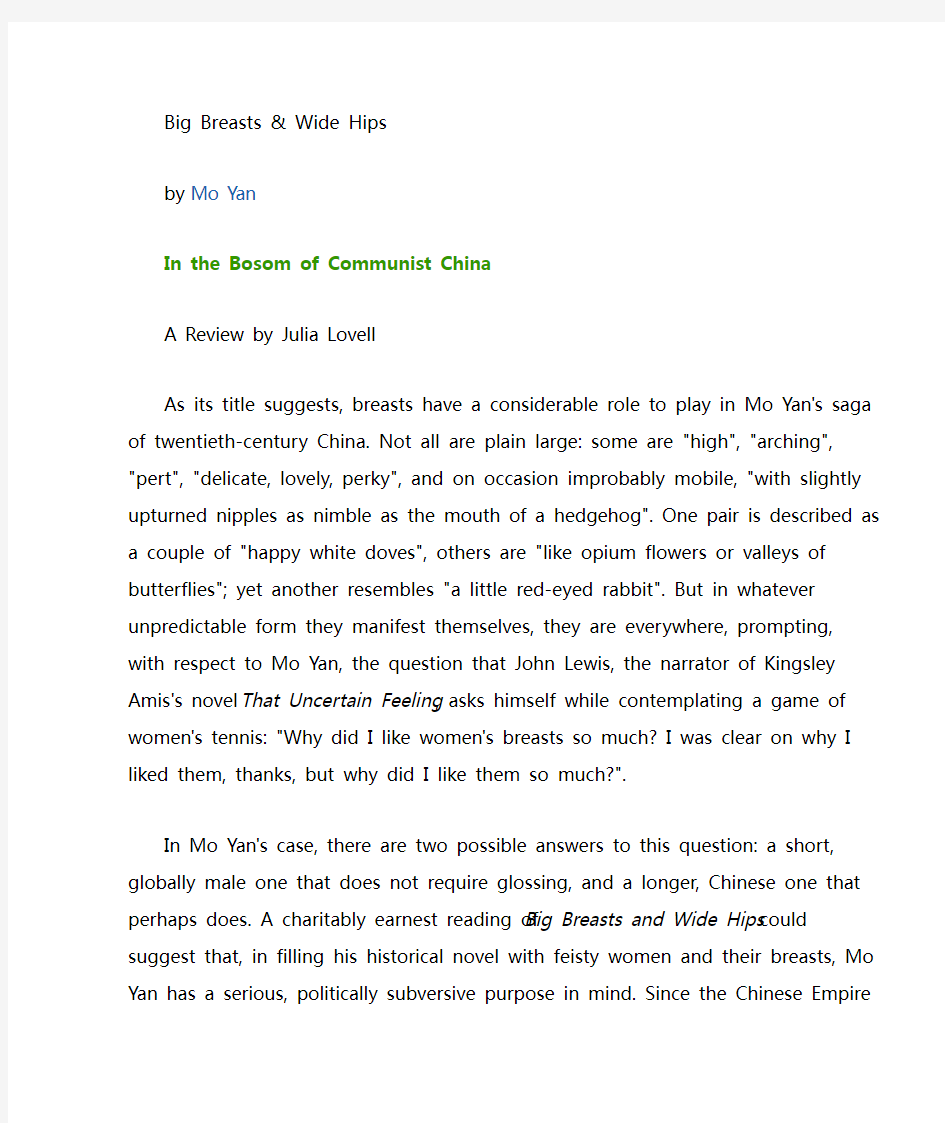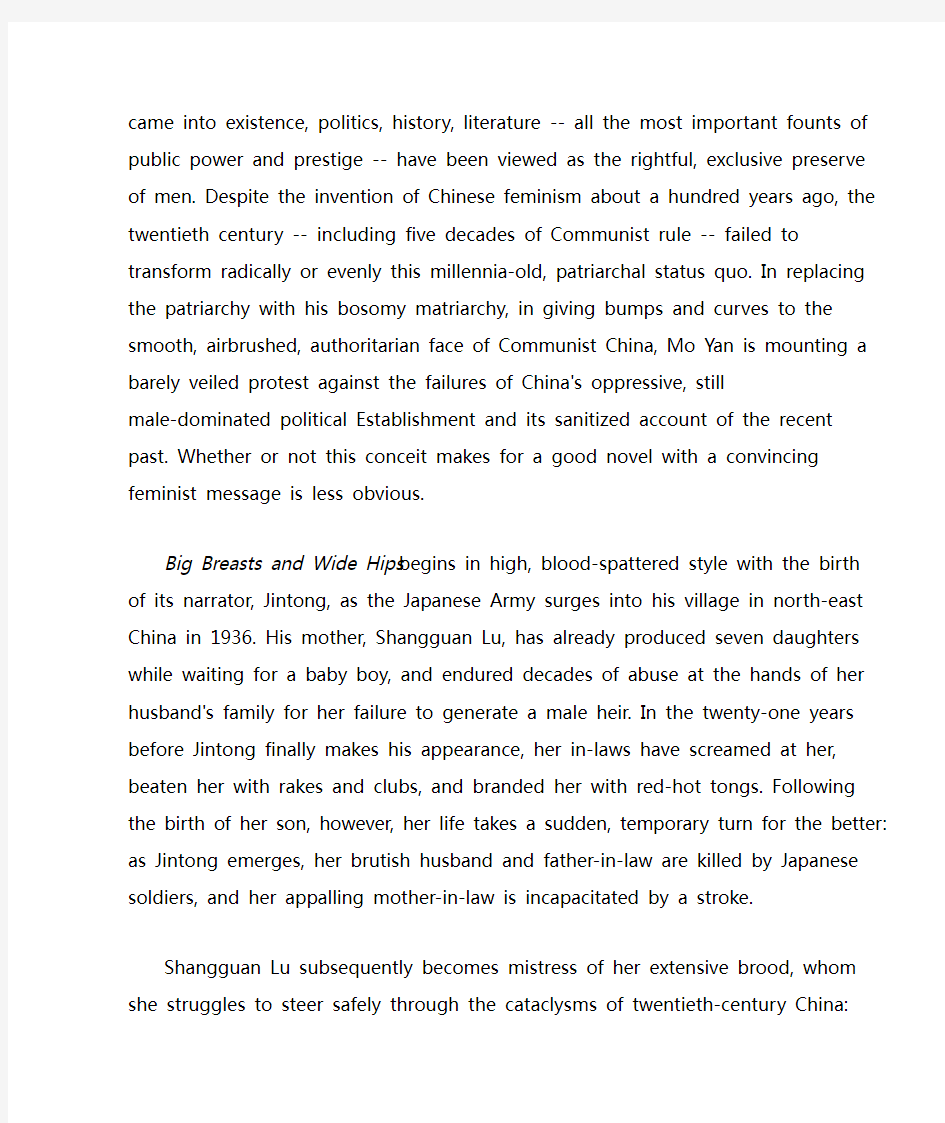Big Breasts and Wide Hips


Big Breasts & Wide Hips
by Mo Yan
In the Bosom of Communist China
A Review by Julia Lovell
As its title suggests, breasts have a considerable role to play in Mo Yan's saga of twentieth-century China. Not all are plain large: some are "high", "arching", "pert", "delicate, lovely, perky", and on occasion improbably mobile, "with slightly upturned nipples as nimble as the mouth of a hedgehog". One pair is described as a couple of "happy white doves", others are "like opium flowers or valleys of butterflies"; yet another resembles "a little red-eyed rabbit". But in whatever unpredictable form they manifest themselves, they are everywhere, prompting, with respect to Mo Yan, the question that John Lewis, the narrator of Kingsley Amis's novel That Uncertain Feeling, asks himself while contemplating a game of women's tennis: "Why did I like women's breasts so much?
I was clear on why I liked them, thanks, but why did I like them so much?".
In Mo Yan's case, there are two possible answers to this question: a short, globally male one that does not require glossing, and a longer, Chinese one that perhaps does. A charitably earnest reading of Big Breasts and Wide Hips could suggest that, in filling his historical novel with feisty women and their breasts, Mo Yan has a serious, politically subversive purpose in mind. Since the Chinese Empire came into existence, politics, history, literature -- all the most important founts of public power and prestige -- have been viewed as the rightful, exclusive preserve of men. Despite the invention of Chinese feminism about a hundred years ago, the twentieth century -- including five decades of Communist rule -- failed to transform radically or evenly this millennia-old, patriarchal status quo. In replacing the patriarchy with his bosomy matriarchy, in giving bumps and curves to the smooth, airbrushed, authoritarian face of Communist China, Mo Yan is mounting a barely veiled protest against the failures of China's oppressive, still
male-dominated political Establishment and its sanitized account of the recent past. Whether or not this conceit makes for a good novel with a convincing feminist message is less obvious.
Big Breasts and Wide Hips begins in high, blood-spattered style with the birth of its narrator, Jintong, as the Japanese Army surges into his village in north-east China in 1936. His mother, Shangguan Lu, has already produced seven daughters while waiting for a baby boy, and endured decades of abuse at the hands of her husband's family for her failure to generate a male heir. In the twenty-one years before Jintong finally makes his appearance, her in-laws have screamed at her, beaten her with rakes and clubs, and branded her with red-hot tongs. Following the birth of her son, however, her life takes a sudden, temporary turn for the better: as Jintong emerges, her brutish husband and father-in-law are killed by Japanese soldiers, and her appalling mother-in-law is incapacitated by a stroke.
Shangguan Lu subsequently becomes mistress of her extensive brood, whom she struggles to steer safely through the cataclysms of twentieth-century China: massacres by the Japanese, assaults by roving bandits, famine, civil war between Communists and the rightwing Nationalists, political persecution under Mao. Her daughters consistently refuse to accept her guidance, one by one choosing unreliable mates -- a bandit leader, a promiscuous local aristocrat, a flighty bird-catcher, a brutish mute, an American bomber pilot -- who draw them into war, treason, insanity and death. Telling the story is Shangguan Lu's favourite, Jintong, for much of the novel a non-participant thanks to his all-consuming obsession with breasts in general, and attachment to his mother's in particular (he is breast-fed until he is seven, and even reverts to the habit in his forties). By the 1980s, as the novel draws to a close, only Jintong and his mother remain alive, the rest victims of history or their own desires.
Until it reaches the Communist period, Mo Yan's attempt to rescue modern China from the bland platitudes of historical propaganda holds roughly together, thanks principally to its strident energy and raucous cast of lovers, bandits and freedom fighters. By omitting, for the most part, conventional calendar dates and direct mention of the Party affiliations and campaigns associated with standard histories of the period, Mo Yan manages to create an entirely localized Chinese world, set amid the wild rivers and fields of the north-east, isolated from any sense of centralized political control. Shangguan Lu's own body and straggling family -- raped, starved, driven out of their homes, sold into prostitution, managing untidily to survive and reproduce, while bandits, foreign invaders and Communist "liberators" tear the country apart -- are the provincial map on which the sufferings of China as a whole are scratched with bloody immediacy.
Beyond 1949, however, Mo Yan loses his shaky grip on technical consistency and control. He abandons his attempt to write a grass-roots history of modern China, increasingly orientating his plot to national, political landmarks, including two of the major mass campaigns of the Maoist years: the Anti-Rightist movement and the Great Leap Forward. After recklessly taking his foot off the narrative brake -- he covers forty years of Communist rule in fewer pages than he has devoted to the previous decade -- he begins to cram his pages with walk-on, walk-off bit-parts: inspirational teachers, thuggish peasants, a repressed female official, a rapist cook. Perhaps aware that he has
over-populated his pages, Mo Yan brusquely begins eliminating his lead characters, the Shangguan daughters (a curious choice of plot direction for a supposedly anti-patriarchal novel): by bomb explosion, firing squad, starvation, syphilis. After some 400 pages, his ingenuity for disposing of people exhausted, he has the blind youngest daughter wander out of the family gate and simply disappear. Later chapters are still dusted with the by now familiar sprinkling of noisy sex and violence -- most notably, the act of necrophilia by which Jintong loses his virginity -- but Mo Yan's literary shock tactics progressively lose their primitive potency through overuse across an overlong book, and quickly become little more than numbing.
The novel's lack of structural and psychological subtlety is aggravated by Mo Yan's stylistic weaknesses -- by language at times wordy and repetitive, at others
uninformatively hackneyed, at others again distractingly bizarre. On one page, as Jintong's bosom fixation -- not for the first time -- gets the better of him, the same pair of breasts are recounted twice over, both times with tired, bodice-ripper cliché "high, arching" and "pert". Admittedly, the gruelling frequency with which breasts pop up throughout the novel makes the task of finding fresh, original terms of description a linguistic challenge. When Mo Yan does reach for his thesaurus, the results can be puzzling. At one point, the narrator is obliged to feel 120 pairs of breasts in rapid succession, in his professional capacity as officiator of a local fertility cult. One pair, he records, "cackled like stubborn hens", another resembled "explosive quails, with brown feathers, unyielding beaks, and short powerful necks". The last in his mammary marathon, he reports, "was the warmest breast I'd ever felt, like a vaccinated rooster, so hot it nearly sparked".
If Mo Yan wants to remake the rigid mould of Chinese Communist Party-sponsored history with any meaningful degree of literary sophistication, he needs to use a sharper instrument than Big Breasts and Wide Hips. And if he thinks he is paying women a compliment by portraying them as significant for their multiform breasts rather than for their ability to think, reason, or even survive in twentieth-century China, it is a compliment they probably ought to think twice before accepting.
仪表基础知识篇
仪表基础知识篇 性能指标 *1、什么是仪表的反应时间? 当用仪表对被测参数进行测量时,仪表指示值总要经过一段时间才能显示出来,这段时间称为仪表的反应时间。 *2、按误差值的表示方法,误差可分为什么? 可分为绝对误差、相对误差、引用误差。 *3、选定的单位相同时,测量值小数点后位数越多,测量越精确吗? 是。 *4、什么叫回差? 回差也叫变差,是在正、反行程上,同一输入的两相应输出值之间的最大差值。(若无其他规定,则指全范围行程) *5、什么叫仪表的死区? 死区是输入量的变化不至于引起输出量有任何可察觉的变化的有限区间,死区用输入量程的百分数表示。 标准仪器 1、如何使用兆欧表进行线路绝缘检查? 答:1)首先检验兆欧表:兆欧表有两个引线接线柱“L”和“E”。“L”表示线路,“E”表示接地。先将“L”和“E”短路,轻轻摇转兆欧表的手柄,此时表针应指到零位。注意不得用力过猛,以免损坏表头。然后将“L”与“E”接线柱开路,摇动手柄至额定转速,即达到每分钟120转,这时,表针应指到∞的位置。2)线间检查:测试前应将被测线路或设备的电源切断,并进行放电。将被测线路或电气设备用两条引线分别接至兆欧表的“L”和“E”接线柱。对地检查:将被测线路及地端用两条引线分别接至兆欧表的“L”和“E”接线柱。 3)测试时以均匀、额定的转速转动兆欧表的手柄,则兆欧表的指针会指示一定的刻度,待一分钟时,读取表针所指的电阻值>0.5MΩ 压力压差测量 基本知识 1、法兰变送器安装时,为什么一定要选择周围环境温度比较恒定的地方?(答:法兰变送器和普通变送器不同,它的毛细管、法兰膜盒是一个密闭系统,相当于一个大温包。当周围环境发生变化时,系统内的填充液会发生膨胀收缩,从而引起系统的压力变化,它作用到变送器的敏感元件,使仪表产生附加误差。而在一般变送器中,引压导管不是密闭系统,它由温度变化而引起压力变化,可以由介质扩散到工艺流程,因而不影响仪表输出。法兰变送器安装时,一定不要使变送器和法兰膜盒系统暴露在阳光底下,以免太阳直晒,使环境温度发生剧烈变化。另外,差压变送器的两根毛细管应处于同一环境温度下,这样,一定范围内的温度变化可以互相抵消。 *2、高温高真空的法兰变送器为什么特别昂贵?() 答:法兰变送器的法兰膜盒直接和介质接触,因此法兰变送器很容易遇到高真空的操作条件。当法兰变送器在真空状态下工作时,隔离膜片受到一个向外的吸力,于是膜片外鼓,使变送器密闭系统的体积增大,填充液内的压力降低,处于真空状态。这时外部的气体有可能从焊缝处、连接处渗透到膜盒内部,使填充液中含
仪表基础知识
测量仪表 第一章基本知识 1. 测量、测量结果应包括那些测量:人们借助于专门设备通过实验的方法,把被测量与所采用的测量单位相比较得到其比值的过程。 测量结果:包含有一定数值和相应的单位名称。 2. 测量误差、真值、实际值测量误差:由于仪表本身的不准确性,使用者素质的高低,测量方法的优劣,环境条件的好坏等因素的影响和制约,使测量值与被测量的真实值之间总是存在着差异,这个差异就是测量误差。 真值:被测量本身所具有的真实大小。实际值:标准表的测量值。 5. 仪表误差有几种表示方法、含义各是什么、根据其性质,可分为哪三类误 差,其内容是什么。 表示方法及含义: 绝对误差:仪表测量示值与被测量的实际值之差8x=Ax —o; 相对误差:仪表的绝对误差与被测量的实际值之比的百分数r x= 8x/ Ao x % 引用误差:仪表的绝对误差与仪表量程之比的百分数r=衣/Am x % 误差分类及内容:系统误差:仪表本身有缺陷,使用不正确,客观环境条件改变等原因产生的误差。有规律、数值固定或有一定规律的变化。 疏忽误差:由工作中的疏忽大意造成。其误差数值难以估计,远超过实际值; 偶然误差:由测量中偶然因数引起的。它决定着测量的精度,误差越小精度越高。 11.测量仪表质量指标有那些,如何利用这些指标判断仪表是否合格精度:仪表最大绝对误差8maX^量程An之比的百分数为仪表的基本误差,r m= 8max/An K %而基本误差的允许值称为允许误差,允许误差去掉百分号的绝对值称为仪表的精度。凡基本误差超出允许误差 的仪表为不合格。 示值变差:指对某一刻度点分别由上升和下降两个方向输入对应该点的同一输入量时,上升和下降示值之差的绝对值与仪表量程之比的百分数。 2 =A h-A下/Am x %凡示值变差超出允许误差的仪表为不合格。 灵敏度:仪表输出变化量△ L与引起该变化量的输入变化量厶X之比称为仪表的灵敏度S。S=A L/ △ X 灵敏度表示仪表对被测量变化的反应 能力,要求灵敏度与仪表允许误差相适应
仪表工基础知识试题大全精选文档
仪表工基础知识试题大 全精选文档 TTMS system office room 【TTMS16H-TTMS2A-TTMS8Q8-
仪表 一、 1、仪的精度级别是指仪表的( 基本误差?)、(最大允许值)。 2、我们无法控制的误差是(随机误差)。 3、差压测量管路冲洗时,应先打开(平衡阀门)。 4、在蒸汽流量阶跃增大扰动下,汽包水位会出现(虚假水位?)。 5、铜热电阻测温范围是(?-50~150℃ )。 6、KX延伸型热电偶补偿线正极为红色,负极为(? 黑 色 )。 7、双金属温度计的型号是(? WSS ? )。 8、接线时,每个接线端子上最多允许接(?2 ? )导 9、补偿导线的正确敷设,应该从热电偶起敷设到(与冷端温度补偿装置同温的地方 10、转子流量计中流体流动方向是(自下而上) 11、热电偶测温原理基于(热电效应)。 12、热电偶信号,在采集过程中,实质上是(电压信号)。 13、在测量蒸汽流量时,在取压口处应加装(冷凝器)。
14、当差压式流量计三阀组正压阀堵死.负压阀畅通时,仪表示值(跑零下)。 15、工业上常用的流量仪表可分为:速度式,体积式和(质量式)。 16、电磁流量计的传感器要有良好的接地,接地电阻应小于(10)Ω。 17、用于测量流通量的导压管线,阀门组回路中,当正压侧阀门或导压管泄露时,仪表示值将(降低)。 18、热电偶通常用来测量(高于等于)500℃的温度。 19、在热电偶测温时,采用补偿导线的作用是(冷端的延 20、一台安装在设备内最低液位下方的压力式液位变送器,为了测量准确,压力变送器必须采用(正迁移) 21、某液位变送器量程为0—4m,在输出信号为14mA时,对应液位为(2.5m 22、有一台智能型温度显示仪,测量范围为设定为0~600℃,其允许误差为±%FS±1个字,则最大误差不超过(±4℃)。 23、测量氨气的压力表,其弹簧管应用(不锈钢)材料。 24、根据化工自控设计技术规定,在测量稳定压力时,最大工作压力不应超过测量上限值的(2/3),测量脉动压力时,最大工作压力不应超过测量上限值的(1/2 25、压力表的使用范围一般在它量程的1/3一2/3处,如果低于1/3,则(相对误差增加)。 26、有一台差压变送器,其量程为10KPa,可实现负迁移,迁移量为10KPa,请问该表测量范围 (-10KPa~0KPa?)。
